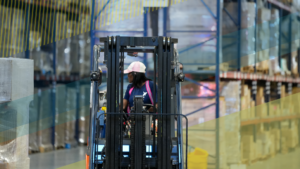Evolving order fulfillment processes allow businesses to stay competitive by improving time to customers. Pick and pack is an essential part to D2C (direct-to-consumer) fulfillment and has a direct impact on customer’s perception on a business due to it being one of the last touch points before reaching them. In this article, we will be covering what pick and pack is, the different methods that can be used, and the future of pick and pack fulfillment as a whole.
What is Pick and Pack?
Pick and pack order fulfillment (or pick and pack) is a process in logistics and e-commerce where individual items are selected, or picked, from inventory (often in a warehouse or distribution center), and then packed into specific orders for shipment to customers. It is part of an end-to-end process of receiving, picking, packing, and shipping orders to customers, and is an essential part of ecommerce order fulfillment process. On the surface, the pick and pack process may seem straightforward, but it requires proper planning to operationalize efficiently.
The Importance of Efficient Pick and Pack
The rapidly growing online shopping sector includes the increased need for same-day delivery. Combine this with the sporadic nature of customer orders that come in, a business’ warehouse operations have to constantly be efficient and prepared to have responsive pick and pack processes that reduce the completion time and get items to customers quicker.
Additionally, with pick and pack being one of the largest portions of warehousing costs for most companies, these pick and pack processes must be efficient to help reduce costs. This will help businesses continue to stay competitive as customer expectations increase.
What Is The Pick and Pack Process?
But what all is involved in the process for pick and pack fulfillment? The process can be outlined in four main steps.
- Order Receipt and Processing: The process begins when an order is received. These orders are then turned into packing slips with information to complete the fulfillment process.
- Picking: Warehouse staff or automated systems locate and retrieve (pick) the individual items from their location in the warehouse. Special picking bins, also known as storage bins, may be used to organize and store products that are waiting to be picked for customer orders. Items are then inspected for quality and accuracy to ensure that the correct products and quantities are being prepared for the order.
- Packing: The selected items are then packed into appropriate containers or packaging materials for shipment. Packing also includes labeling the packages with shipping information, including the destination address and any required shipping labels.
- Sorting and Shipping: The packed orders are prepped and staged for pickup, sorted based on their destination and shipping method. Once they are picked up, the carrier will deliver them to the final destination.
The Different Picking Methods
Depending on your business’s size and products, there are different pick and pack methods that may work better for you. Here are some of the standard pick and pack methods that are used in the ecommerce space.
Piece Picking
In instances where a business may only have a few orders to fulfill daily, a piece picking method may make the most sense. With piece picking, a picker will follow the packing slip for a single order picking each item for that customer. They would then take it to the packing station where they would inspect, package, and label the products for shipping.
Batch Picking
Batch picking is when a picker collects items for multiple different orders simultaneously. By using this approach, you avoid the need to go back and forth to collect items in the same area. Additionally, grouping multiple different orders in one pick minimizes the amount of people that are moving through aisles at once. This allows for quicker and more efficient movement throughout the warehouse for all staff. A batch picking approach works well for businesses that have larger daily order amounts.
Zone Picking
Zone picking consists of dividing the warehouse into different zones or areas. Each zone contains specific items or product categories, and a picker is responsible for collecting products from their assigned zone. They then pass the order to the worker in the next zone until it makes it to the packing station. By assigning specific areas to individual pickers, they become experts in the products within their zone, which can lead to faster and more accurate picking. This approach is particularly useful for businesses with a wide range of products.
Wave Picking
Wave picking combines both batch and zone picking methods. Workers will pick items for multiple orders that are in their zone simultaneously. This strategy is specifically advantageous for businesses that have a large fulfillment space with hundreds of different SKUs.
What Type of Equipment is Used for Pick and Pack Orders?
To complete the pick and pack process, there are various types of equipment used to accurately fulfill customers orders. The equipment used will depend on multiple different factors such as product size and weight, scale of pick and pack operations, and the level of automation in your fulfillment space. Here are some common equipment that are used during pick and pack order fulfillment:
Handheld Devices
Barcode Scanners: Handheld barcode scanners are used to confirm the item’s identity during the picking process. These scanners can also be used for other warehousing operations such as inventory management and order tracking.
Mobile Computers: These computers have integrated computing functions that allow for pickers to see the pick ticket and collect the right items.
Conveyor Systems
Conveyor systems may be integrated into a warehouse’s pick and pack processes. They are used to transport products from one location to another without using warehouse staff. This allows for quicker movement between the picking, packing, and shipping stations.
Automated Guided Vehicles
Automated Guided Vehicles (AGVs) are mobile robots that move items through the warehouse. Much like conveyor systems, it reduces the need for staff movement through the warehouse.
Automated Storage and Retrieval Systems
Automated storage and retrieval systems (AS/RS) store and collect items from their designated areas in the warehouse. By integrating them into your pick and pack process, businesses can automate their picking of products.
Packaging Equipment
Box Sealers and Tapers: Automated machines that seal and tape cardboard boxes.
Void Fill Systems: Equipment used to fill empty spaces in packages with materials like air pillows or packing peanuts to prevent damage during transit.
Label Applicators: Machines that apply shipping labels to packages automatically.
Automated Packaging Machines
These machines automatically package and seal items into an array of packaging formats such as bags, pouches, and boxes.
Lifting and Material Handling Equipment
Forklifts, pallet jacks, and other lifting equipment are used to move pallets and large quantities of products within the warehouse.
RFID Technology
Radio-frequency identification (RFID) systems use tags and readers to identify and track items, providing real-time visibility into inventory and aiding in the pick and pack process.
Pick and Pack Best Practices
When creating pick and pack strategies to increase efficiency, there are a few best practices to follow.
Plan picking routes to save time
With traveling during the picking process taking up 55% of all picking time, it’s important to make sure the picking routes for staff are optimized as much as possible. When planning the picking route that is most optimal, it’s important to consider:
- The size and layout of the facility will dictate the most efficient route for people to take.
- The distance between items that may be picked together in the same order.
- Your high demand items. These items should be closer to the picking station to finish orders faster.
Use barcode scanning to avoid errors
The picking process is primarily labor intensive which can lead to mis-picks that turn into unhappy customers and wasted inventory. Barcode scanners provide the warehouse staff with useful information to see the exact product they will need to pick. By having workers use the barcode scanner to verify every item, your picking accuracy improves significantly. In addition, scanners provide real-time inventory updates to maintain more accurate inventory estimates.
Increase efficiency with a WMS
Integrating with a warehouse management system (WMS) is recommended for having efficient processes. Businesses will get benefits from the WMS like automated workflows, optimized stock control, and location management software. As businesses grow, their picking processes can be supported by automation, ensuring their growing sales can be completed.
Fulfill With Nautical
If you are looking for a reliable and efficient fulfillment partner, Nautical has worked with some of the largest brands to ensure their products are fulfilled in a timely manner. Whether you are a B2C business looking for top-of-the-line pick and pack services, or a B2B business looking for retailer fulfillment solutions, we have the custom fit solution for any of your needs. Contact us today to speak to our team of fulfillment experts and take your supply chain efficiency to the next level.
Pick and Pack FAQ
How Does Pick and Pack Work?
The pick and pack process can be broken down into four main steps. First, the product is received at the fulfillment center and stored until ready for fulfillment. Once the products are ready to be fulfilled, staff begin to pick products from their areas in the warehouse. These are then packaged and prepared for shipping. Once this is complete, the products are loaded and shipped to the final destination.
What are the Benefits of Pick and Pack?
Efficient pick and pack processes greatly improves fulfillment times and reduces costs for the company greatly. With the process being one of the more expensive processes, it’s vital to have efficient processes to reduce this, improving your bottom-line.
What is the Cost for Pick and Pack Fulfillment?
When outsourcing this service to a third party provider, there are multiple different fees that businesses should be prepared to pay:
Pick Fee: This fee is charged for each individual item that is picked from the inventory to fulfill an order.
Order Fulfillment Fee: Some providers charge a combined fee that includes both picking and packing, often referred to as an order fulfillment fee.
Storage Fee: If your products are stored in a fulfillment center for an extended period, you may be charged a storage fee based on the space your products occupy.




